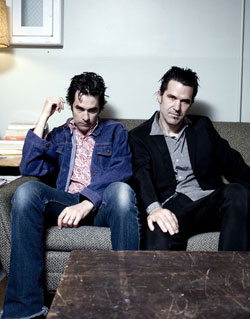 There it is in my e-mail inbox, in all caps, the crux of the matter from Jon Spencer: “I HAVE NO SOUL AND MY HEART IS BARREN. MY WORDS ARE EMPTY AND FALSE.” Spencer, one half of Heavy Trash and the titular man of Jon Spencer Blues Explosion, is explaining why one critic described him as a “mendacious con man.”
There it is in my e-mail inbox, in all caps, the crux of the matter from Jon Spencer: “I HAVE NO SOUL AND MY HEART IS BARREN. MY WORDS ARE EMPTY AND FALSE.” Spencer, one half of Heavy Trash and the titular man of Jon Spencer Blues Explosion, is explaining why one critic described him as a “mendacious con man.”
But this answer is, of course, a con. Spencer’s got soul. His heart is not barren. His words aren’t empty, although they may sometimes be false.In fact, it’s his other musical half, Matt Verta-Ray, who has the charming, fast-talking demeanor of a con man. Spencer, in person, is almost distressingly straightforward.
Collapsed on ratty couches in their basement recording studio on the Lower East Side, Spencer and Verta-Ray are answering a few questions in their down time. They’ve finished with the recording and mixing of their sophomore album, Going Way Out with Heavy Trash, and are trying to find time to breathe before the accompanying tour.
Seated together now, they look like two different artists’ renderings of the same basic idea: the dark-haired, lanky rockabilly dude. The Verta-Ray version is baby faced and slick; he looks like a rockabilly Morrissey. Spencer looks a little more frayed around the edges, but they’re both sharp-dressed men.
“There are millions of Italian silkworms toiling away in Milan and Rome,” explains Verta-Ray, “making those shimmering fabrics to be custom-sewn into suits for me and Jon. I personally don’t have the heart to disappoint them all by wearing anything else. I even wear sharkskin condoms. Ladies?”
Verta-Ray and Spencer are both products of the ‘70s, a time when mainstream rock was tilting toward the bloated and the “prog.” Their love of rockabilly was at least in part a reaction to that climate.
“The grittiness of the delivery and the subject matter [of rockabilly] made all of Led Zeppelin’s wailing about hobbits and Mordor and stuff seem pretty lame,” says Verta-Ray.
So instead they mixed rockabilly with punk; the results were the crazed, revved-up howlings of Verta-Ray’s Speedball Baby and Jon Spencer’s Blues Explosion. From rockabilly, they took the basic sound; from punk, they drew confidence and a willingness to experiment.
The big lessons [from hardcore music] were [that] you can have a band, you can make a record, do it yourself, put it out, go out on tour. Get in the van.
“I think that hardcore taught me a lot,” says Spencer. “It wasn’t my favorite kind of music, but the big lessons were yeah, you can have a band, you can make a record, do it yourself, put it out, go out on tour. Get in the van. At a certain point I didn’t want to do anything else.”
Eventually, moving in the same subculture of tattooed pyschobilly shows, they took notice of one another. “We both could tell the other’s influences,” says Spencer. “We knew that we shared a lot of common ground.”
“We both had some down time, started writing songs and playing together, but no one was calling it a band yet,” adds Verta-Ray. “And since we have the studio, before we knew it, there was an album. And then we named the band.”
The first, self-titled Heavy Trash record came out on Yep Roc Records in 2005. (Yep Roc, based in Chapel Hill, has become the home for the modern rockabilly/pyschobilly scene with a roster that includes Southern Culture On The Skids, the Reverend Horton Heat, Dexter Romweber of the Flat-Duo Jets, and the Legendary Shack Shakers.)
The rockabilly/swing subculture has waxed and waned in popularity over the years, seeing occasional breakouts into the mainstream (The Stray Cats, Brian Setzer) and always being available as a proudly stylish, parallel way of life — one with, in general, a friendlier attitude than the sometimes exclusive genre of indie rock.
For both artist and audience, it’s more openly about putting on a show (as Verta-Ray points out) than about a sense of slacker cool. Because they evoke a more innocent era, the new rockabilly crowd is also able to toy with being sleazy. They can be suggestive again. It’s much more fun than being overt — in the same way that James Bond movies are sexier than porn.
“I remember the rockabilly sound kind of popping out from everything else around at the time I was first exposed to it,” says Verta-Ray, “and feeling that there was something real there that was not happening in AM radio or disco or heavy album rock, all of which was in style then. I can kind of pick apart the feeling of rockabilly’s appeal for me and put it down to slapback delay, relatively home-made recording techniques, tube technology, rebellious youth energy, and cool black and white pictures of greasy hepcats.
“But at the time, I didn’t even know there was a term for it and naturally just gravitated to Luther Perkins’ solo in ‘Get Rhythm’ or Buddy Holly’s sound on ‘That’ll Be The Day’.”
If you’re presently on a musical diet of hyper-literate singer/ songwriters, electronic noise-shapers, and remixes of remixes, it can be jarring to listen to the first notes of Going Way Out. It’s a primitive, forgotten pleasure. This music has been at the base of most pop for the past fifty years; it’s so fundamental that it’s hard to imagine anyone actually creating it. The music is so straightforward that you can easily think, “I could do this.” A little ringing guitar, a little echo, some hiccupping-Hank Williams vocals, and you’ve got a song. But simplicity is not always easy.
